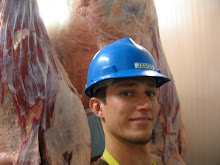
First on the agenda was touring the National University of Cusco, the only major agriculture university for the region. The class was led to the agricultural experiment area where we met up with a professor and a few students. We looked at their dairy operation, which was quite primitive to our standards. The feed the animals eat is pretty poor overall, and you can tell by looking at the skinny animals. This wasn't a Prather Ranch operation, that's for sure. We learned the average production in California per animal was about 4 to 5 times as much as their best milking cow.

We walked around an experimental farm, and looked at their drip irrigation demonstrations and their hydroponic experiments. It seemed as if I’ve stepped back in time, I take for granted how much more advanced we are with our agriculture in California. Looking at the plants, they are very healthy. They had cabbage, lettuce and potato trials. Another interesting thing was that they are just starting to experiment with production of artichokes, and have been quite successful. After viewing Agrokasa and their domination of the asparagus industry, it made me think that the artichoke farmers in California have some serious competition brewing.
The class then headed up to some mountains overlooking Cusco and viewed the magnificent ruins of the Sacsayhuaman. Stones weighing over 125 tons were intricately stacked together with miniscule seams, an engineering feat that still amazes me. The site has massive walls with a zig-zag shape in multiple terraces. This was the location of a rebellion staged against the Spanish in 1536. The site also contained three large towers, which unfortunately were demolished by the Spanish after they quelled the rebellion. The view of Cusco from the site was stunning.
Other Inca sites were visited, including Tambomachay and Q’enqo. Tambomachay is a sacred bathing place for the Inca rulers, with an elaborate aqueduct system and a series of cascading waterfalls. Q’enqo is an Inca shrine with a circular amphitheater and a large stone that represents a puma.

The class then retreated to the bus as the forming clouds overhead finally started to pour. We made it back down to Cusco and enjoyed lunch at a small place overlooking one of the many plazas in town. We made the mistake of sitting outside, as we were swarmed with many Peruvians selling a variety of wares, finger puppets, hats, paintings and cigarettes.
After a quick rest in the hotel I went out on a solo mission throughout Cusco. It was dark and the streets were packed. Being with a large group, its always nice to be able to break away and find a little time to collect your thoughts by yourself. I wandered around, blending in much more than walking with a few other gringos. Dinner that night was another amazing blend of flavors- I can really get into this Peruvian food! A great end to the last night in Peru.





No comments:
Post a Comment